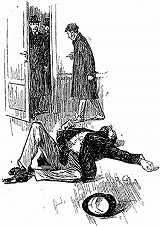
All these details I observed afterwards. At present my attention was centred upon the single, grim, motionless figure which lay stretched upon the boards, with vacant, sightless eyes staring up at the discoloured ceiling. It was that of a man about forty-three or forty-four years of age, middle-sized, broad-shouldered, with crisp curling black hair, and a short, stubbly beard. He was dressed in a heavy broadcloth frock coat and waistcoat, with light-coloured trousers, and immaculate collar and cuffs. A top hat, well brushed and trim, was placed upon the floor beside him. His hands were clenched and his arms thrown abroad, while his lower limbs were interlocked, as though his death struggle had been a grievous one. On his rigid face there stood an expression of horror, and, as it seemed to me, of hatred, such as I have never seen upon human features. This malignant and terrible contortion, combined with the low forehead, blunt nose, and prognathous jaw, gave the dead man a singularly simious and ape-like appearance, which was increased by his writhing, unnatural posture. I have seen death in many forms, but never has it appeared to me in a more fearsome aspect than in that dark, grimy apartment, which looked out upon one of the main arteries of suburban London.
Lestrade, lean and ferret-like as ever, was standing by the doorway, and greeted my companion and myself.
“This case will make a stir, sir,” he remarked. “It beats anything I have seen, and I am no chicken.”
“There is no clue?” said Gregson.
“None at all,” chimed in Lestrade.
Sherlock Holmes approached the body, and, kneeling down, examined it intently. “You are sure that there is no wound?” he asked, pointing to numerous gouts and splashes of blood which lay all round.
“Positive!” cried both detectives.
“Then, of course, this blood belongs to a second individual - presumably the murderer, if murder has been committed. It reminds me of the circumstances attendant on the death of Van Jansen, in Utrecht, in the year ’34. Do you remember the case, Gregson?”
“No, sir.”
“Read it up - you really should. There is nothing new under the sun. It has all been done before.”
As he spoke, his nimble fingers were flying here, there, and everywhere, feeling, pressing, unbuttoning, examining, while his eyes wore the same far-away expression which I have already remarked upon. So swiftly was the examination made, that one would hardly have guessed the minuteness with which it was conducted. Finally, he sniffed the dead man’s lips, and then glanced at the soles of his patent leather boots.
“He has not been moved at all?” he asked.
“No more than was necessary for the purpose of our examination.”
“You can take him to the mortuary now,” he said. “There is nothing more to be learned.”
Gregson had a stretcher and four men at hand. At his call they entered the room, and the stranger was lifted and carried out. As they raised him, a ring tinkled down and rolled across the floor. Lestrade grabbed it up and stared at it with mystified eyes.
“There’s been a woman here,” he cried. “It’s a woman’s wedding ring.”
He held it out, as he spoke, upon the palm of his hand. We all gathered round him and gazed at it. There could be no doubt that that circlet of plain gold had once adorned the finger of a bride.
“This complicates matters,” said Gregson. “Heaven knows, they were complicated enough before.”
“You’re sure it doesn’t simplify them?” observed Holmes. “There’s nothing to be learned by staring at it. What did you find in his pockets?”